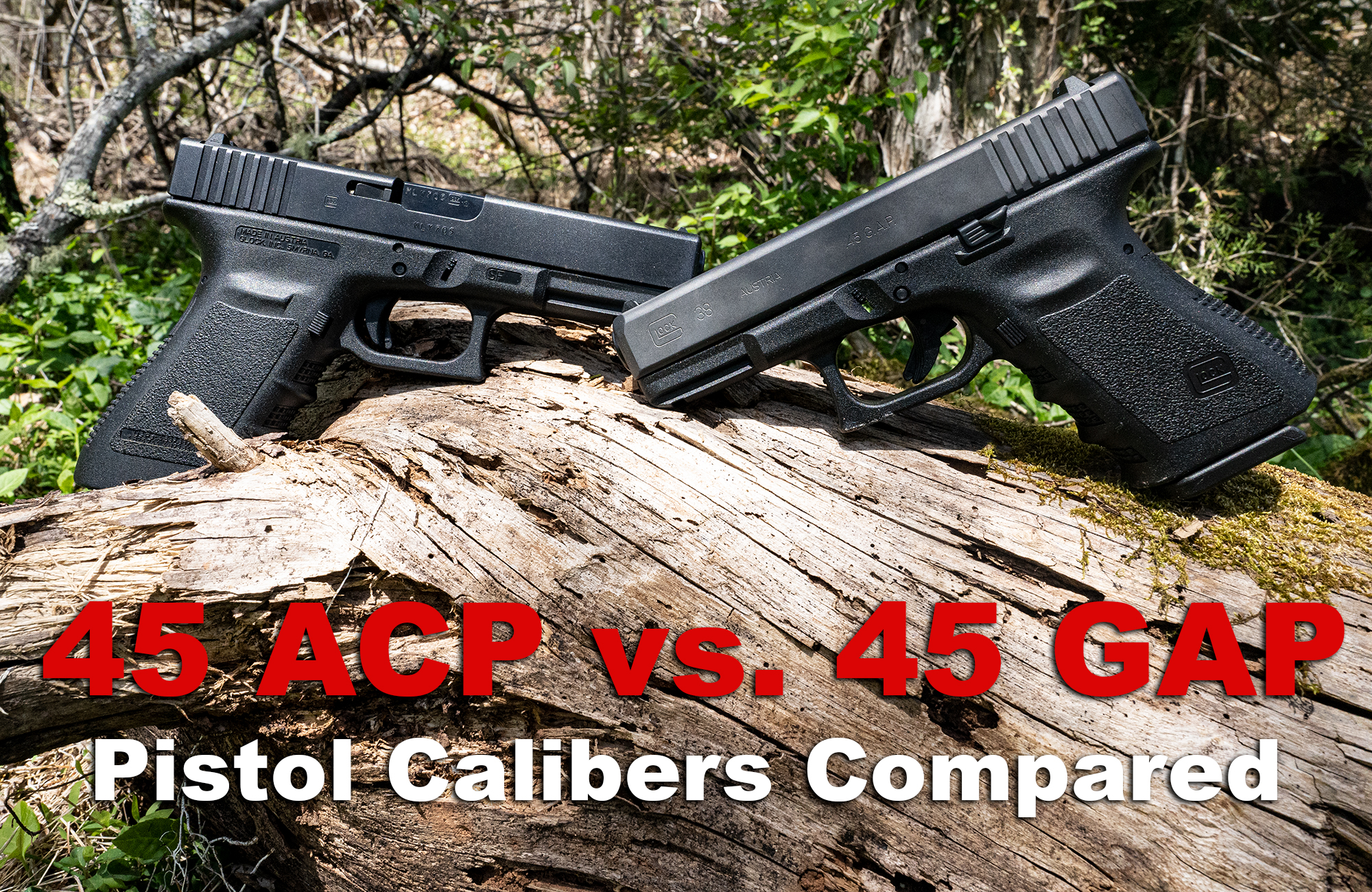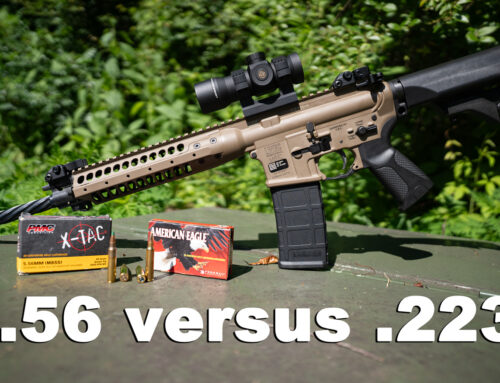The 45 ACP (aka 45 Auto) is here to stay. As the standard ammunition for the M1911 pistol, which has been in service with the U.S. Armed Forces for over 110 years, the 45 ACP is as much a part of America as it is a .45 caliber handgun cartridge.
It only follows that the 45 ACP should have a large, devoted following. And it does. As a commenter on an M1911 forum once put it: “We’re called boomers because our guns go boom.” 45 ACP fans would no sooner switch to a different round than they would request spaghetti for Thanksgiving dinner.
45 ACP vs 45 GAP In A Nutshell
The 45 Auto is a slightly larger cartridge but the two calibers perform similarly in most pistols. 45 GAP is tougher to find when it comes to ammo and generally more expensive to shoot. The two calibers are not interchangeable in handguns because of the cartridge size differences.
Why Did Glock Introduce 45 GAP?

All of this is to say that Glock had some stones when they introduced the 45 GAP in 2003. Inspired by the success of shortening (and taming) the 10mm until it became the 40 S&W, Glock decided they could repeat it by introducing what’s basically a shortened version of the 45 ACP.
The 45 GAP does accomplish its goal, as its case is 0.143” shorter than the 45 ACP. The 45 GAP can do this without sacrificing performance because it is designed for modern powder. Modern powder is smaller in volume than the powder available to Browning around the turn of the century. Glock also strengthened the case to reduce the chance of a neck blowout. They did not try to make their 45 GAP pistol more or less powerful than its predecessor.
Here’s where Glock went wrong. The 40 S&W became popular because it delivers performance comparable to a light 10mm load out of a significantly smaller handgun. But the G37 handgun, which is chambered for 45 GAP, is only about half an ounce lighter than the 45 ACP G21!
Compare that to Glock’s 40 S&W handgun, which is 7 ounces lighter than their 10mm model, and you can better appreciate how Glock dropped the ball. They shrank the cartridge, but they defeated their purpose by not shrinking the firearm to match.
The 45 GAP flopped. If there are still any law enforcement agencies still using it, then they won’t for much longer. Very few private citizens use it, too. If you’re thinking of buying a 45 GAP handgun, go into it knowing that finding the ammo you want can be frustrating.
All of that aside, we have to ask: Does the 45 GAP do the same thing as the 45 ACP – just out of a smaller package? Let’s compare their ballistics, stopping power and recoil to see just how well Glock did at matching the 45 ACP.
Cartridge Dimensions: 45 ACP vs 45 GAP
45 ACP vs 45 GAP - Specs
| 45 ACP | 45 GAP | |
|---|---|---|
| Parent case | -- | 45 ACP |
| Case type | Rimless, straight | Rimless, straight |
| Bullet diameter | 0.452 in | 0.451 in |
| Neck diameter | 0.473 in | 0.4732 in |
| Base diameter | 0.476 in | 0.476 in |
| Rim diameter | 0.480 in | 0.470 in |
| Case length | 0.898 in | 0.755 in |
| Overall length | 1.275 in | 1.070 in |
| Maximum pressure | 21,000 psi | 23,000 psi |
On its exterior the 45 GAP truly is a shorter version of 45 ACP ammo: fundamentally identical bullet and chamber pressure, with less brass to contain both. The 45 GAP’s shorter case is nothing modern powder cannot compensate for. So, on paper, there’s no reason why we should expect these two rounds to do their jobs any differently from one another. But what about in practice?
Ballistics Compared
Velocity Comparison
| 45 ACP Speer Gold Dot 185gr JHP | 45 GAP Speer Gold Dot 185gr JHP | 45 ACP Hornady Custom 200gr JHP | 45 GAP Speer Gold Dot 200gr JHP | 45 ACP Winchester 230gr FMJ | 45 GAP Winchester 230gr FMJ | |
|---|---|---|---|---|---|---|
| Muzzle velocity (fps) | 1050 | 1020 | 900 | 950 | 835 | 850 |
| Velocity @ 25 yds | 999 | 974 | 878 | 921 | 817 | 832 |
| Velocity @ 50 yds | 957 | 935 | 857 | 896 | 800 | 816 |
| Velocity @ 75 yds | 921 | 902 | 837 | 872 | 784 | 799 |
| Velocity @ 100 yds | 889 | 871 | 818 | 850 | 769 | 784 |
We tried to select the most apples-to-apples rounds to compare to each other, one for each of the 45 GAP and 45 ACP’s common shared bullet weights: 185, 200 and 230 grains. As our ballistic data show, these two rounds do indeed deliver similar ballistic performance. No 45 GAP round’s muzzle velocity is substantially different from a weight-matched 45 ACP. Bullet drop may be faster for one round or the other depending solely on the bullet weight.
Here is a good place to point out that the 45 ACP offers an advantage which the 45 GAP does not: overpressure ammunition. A 45 ACP +P cartridge may kick more, but it’s also going to supply a flatter trajectory that terminates in more kinetic energy. You may theoretically load your own 45 GAP +P. To our knowledge it has never been produced commercially.
Stopping Power of 45 ACP vs 45 GAP
| 45 ACP Speer Gold Dot 185gr JHP | 45 GAP Speer Gold Dot 185gr JHP | 45 ACP Hornady Custom 200gr JHP | 45 GAP Speer Gold Dot 200gr JHP | 45 ACP Winchester 230gr FMJ | 45 GAP Winchester 230gr FMJ | |
|---|---|---|---|---|---|---|
| Muzzle energy (ft lbs) | 453 | 427 | 360 | 401 | 356 | 369 |
| Energy @ 25 yds | 410 | 390 | 342 | 377 | 341 | 354 |
| Energy @ 50 yds | 376 | 360 | 326 | 356 | 327 | 340 |
| Energy @ 75 yds | 348 | 334 | 311 | 338 | 314 | 326 |
| Energy @ 100 yds | 325 | 312 | 297 | 321 | 302 | 314 |
Several factors determine how effectively a cartridge can neutralize a threat. Because the 45 ACP and 45 GAP are firing essentially identical bullets, their initial wound channel diameter and sectional density (which describes a bullet’s potential for penetration) are both the same. But the amount of energy the bullet can transfer to its target on impact – that is without question the most important determinant of stopping power.
The 45 GAP holds its own against its predecessor as far as energy on impact is concerned. Depending on which company manufactured the ammo, you might see the 45 GAP or the 45 ACP hitting its target harder.
It should be noted that the 45 GAP, despite Glock’s intention, is often regarded as performing like a slightly weaker version of the 45 ACP. We haven’t noticed this, although that’s not to argue with someone who has.
Trajectory
Trajectory Comparison
| 45 ACP Speer Gold Dot 185gr JHP | 45 GAP Speer Gold Dot 185gr JHP | 45 ACP Hornady Custom 200gr JHP | 45 GAP Speer Gold Dot 200gr JHP | 45 ACP Winchester 230gr FMJ | 45 GAP Winchester 230gr FMJ | |
|---|---|---|---|---|---|---|
| G1 ballistic coefficient | 0.113 | 0.112 | 0.154 | 0.142 | 0.163 | 0.170 |
| Elevation @ 25 yds | 0.01 | 0.01 | 0.01 | 0.01 | 0.01 | 0.01 |
| Elevation @ 50 yds | -2.17 | -2.28 | -2.81 | -2.55 | -3.24 | -3.13 |
| Elevation @ 75 yds | -6.71 | -7.06 | -8.59 | -7.82 | -9.89 | -9.53 |
| Elevation @ 100 yds | -13.82 | -14.5 | -17.47 | -15.94 | -20.06 | -19.34 |
Neither of these calibers is considered a darling for long-range use. We include this table more out of morbid curiosity than any real practical use-case. You can see the 45 ACP and 45 GAP are quite comparable when it comes to bullet drop out of 100 yards.
Recoil

Handguns with lighter recoil are preferable for self-defense. They produce comparatively less muzzle flip, which in turn facilitates rapid, accurate fire. In other words, when the threat is advancing, and you’ve missed with your first shot, you want to take as little time as possible aiming your second. If he wasn’t sure of it before, the first shot proves to the threat that it’s either him or you.
Comparing the recoil energy of the six rounds above is easy. We already have their bullet weights and muzzle velocities; now we just need their propellant weights and firearm weights. For the sake of comparison, lets say the 45 ACP rounds have six grains of powder and the 45 GAP rounds have five. Furthermore, the 45 ACP rounds are fired from a 29.28 ounce G21 handgun; the 45 GAP rounds, a 28.75 ounce G37 handgun.
| Recoil Energy (ft lbs) | |
|---|---|
| 45 ACP Speer Gold Dot 185gr JHP | 8.72 |
| 45 ACP Hornady Custom 200gr JHP | 7.64 |
| 45 ACP Winchester USA 230gr FMJ | 8.55 |
| 45 GAP Speer Gold Dot 185gr JHP | 8.06 |
| 45 GAP Speer Gold Dot 200gr JHP | 8.16 |
| 45 GAP Winchester USA 230gr FMJ | 8.58 |
The takeaway: These two cartridges generate practically identical amounts of recoil energy. You may notice a slight difference between the two. Of course, a heavier handgun will always dampen felt recoil, but you will not benefit from a significant reduction in kick by choosing one round over the other.
Price & Availability
After the 9mm, the 45 ACP is the second most popular centerfire handgun cartridge in America. So as long as handguns are manufactured, the 1911 will remain in print. This makes finding 45 ACP ammo as easy as going online or to a sporting goods store. It also makes 45 ACP firearms no more expensive than the market will allow.
45 GAP is a different story. You can buy a G37 easily enough, as Glock still makes it. But finding 45 GAP ammo – let alone a good variety of 45 GAP ammo – can be frustrating. Demand for 45 GAP simply isn’t high enough for ammo manufacturers to consistently commit raw materials to its production. As a result, selection can be scarce during even the best of times.
Takeaway
Across the board, the 45 GAP really does perform similarly to the 45 ACP. It can be exactly as accurate, powerful and easy to handle as its predecessor. But the 45 GAP just didn’t offer enough for shooters to switch over from a round that was already so well-established and popular.
The 45 GAP will linger on for a while longer, but we expect it to ultimately exit production. Years from now it will live on only as a curiosity among handloaders enjoy hand-crafting their cartridges to their exact specifications.
We don’t think we could say it any more plainly: Don’t buy a 45 GAP handgun. The 45 ACP does everything the newer cartridge does – it’s just a thousand times more abundant, and it’s not going away anytime soon.






Leave A Comment